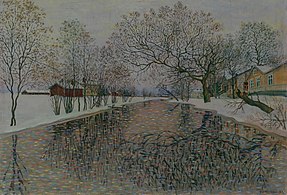You can help expand this article with text translated from the corresponding article in Finnish. (November 2017) Click for important translation instructions.
|
| Vilho Lampi | |
|---|---|
 | |
| Born | 19 July 1898 Oulu, Finland |
| Died | 17 March 1936 (1936-03-18) (aged 37) Oulu, Finland |
| Nationality | Finnish |
| Known for | Painter |
Vilho Henrik Lampi (19 July 1898 – 17 March 1936) was a Finnish painter who is best known for his self-portraits and paintings of Liminka and the people who lived there.
History
Lampi was born in Oulu but lived in Liminka for most of his life. He studied at the Finnish Academy of Fine Arts from 1921 to 1925 and after finishing his studies he returned to Liminka, where he lived and painted his most famous works.




Lampi committed suicide on 17 March 1936 by jumping from a bridge to Oulujoki while visiting in Oulu.

Literature
- Unto Immonen: Vilho Lampi, lakeuden melankoolikko in Suomen taiteen vuosikirja 1956–1957, Porvoo, 1957. (in Finnish)
- Paavo Rintala: Jumala on kauneus, (novel about Vilho Lampi) Otava, 1959. (in Finnish)
- Eeli Aalto: Vilho Lampi, lakeuden maalari : esittelyä ja taustaa, Arvi A. Karisto, Hämeenlinna, 1967. (in Finnish)
- Marja Junttila et al.: Vilho Lampi 1898–1936, ARS Nordica & Kustannus Pohjoinen, 1998 ISBN 951-749-312-6 (in Finnish)
Films
- Eeli Aalto: Vilho Lampi, Lakeuden maalari, 1966.
- Hannu Heikinheimo: Jumala on kauneus, 1985.
Plays
- Kaija Viinikainen: Jumala on kauneus, Kajaanin kaupunginteatteri, 1981.
- Kristian Smeds: Jumala on kauneus, Teatteri Takomo, 2000 and Finnish National Theatre, 2008.
- Taisto Reimaluoto: Tässä on elämä, Kajaanin Runoviikko, 2001.
Gallery
-
 Chair, 1928
Chair, 1928
-
 Rural View, 1929
Rural View, 1929
-
 Granary, 1929
Granary, 1929
-
 Ponderer, 1929
Ponderer, 1929
-
 Ruhmu-Jussi, 1929
Ruhmu-Jussi, 1929
-
 Horse-Copers, 1930
Horse-Copers, 1930
-
Emperor of the Parish, 1930
-
 Moonshiners, 1930, with the artist himself in the middle
Moonshiners, 1930, with the artist himself in the middle
-
 Decapitator, 1930
Decapitator, 1930
-
 Liminganjoki River, 1934
Liminganjoki River, 1934
See also
References
- Vieru, Elina (21 March 2005). "Lampi, Vilho (1898 - 1936)". Kansallisbiografia. Retrieved 18 August 2020.
- Valjakka, Timo (13 March 2020). "Liminkalaisen Vilho Lammen teokset ovat täynnä ekspressionismin uhmaa ja lakeuden kauneutta". Helsingin Sanomat. Retrieved 18 August 2020.
- Ahonen, Hanna-Mari (1 March 2020). "Miksi Vilho Lammesta tuli myyttinen taiteilija? Pimeän pohjolan synkkä erakko muistetaan kotiseudulla rehevänä puhujana – silti kaikki päättyi tragediaan". Lapinkansa. Retrieved 18 August 2020.
- "Vilho Lampi". Helsinki Art Museum. Retrieved 18 August 2020.
- "Viimeiset vuodet". Oulu Art Museum (in Finnish). Retrieved 28 December 2016.
External links
- Vilho Lampi Oulu City Art Museum (in Finnish and English)
- Vilho Lampi's works, Finnish National Gallery (in Finnish, Swedish, and English)
- Vilho Lampi Biografiakeskus (in Finnish)
- Vilho Lampi on artnet (in English)
- Vilho Lampi Auction Sales and Art Market Information artprice.com (in English)